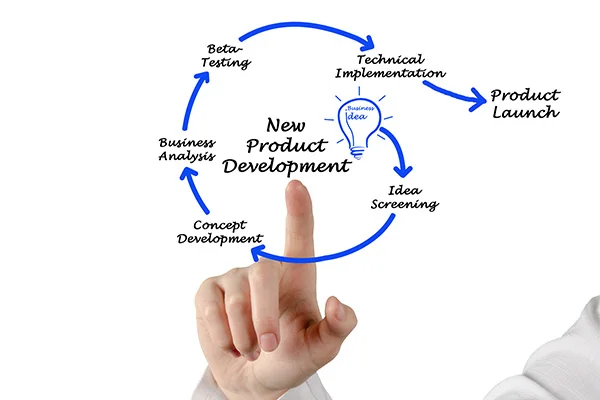The New Product Development Process
- Home
- Blog Details

- December 11 2018
- admin
You might be a seasoned design professional thinking “What do my bosses sit around and do all day while I do the real design work”.
This section outlines and explores the various early stages of the industrial design process that a product goes through. It does serve as a reasonable account of the overall and general product design process.
Before any design work can begin on a product, there must first be a definition of what the product or product line might be. The idea’s genesis can be many factors such as:
Staying ahead of the competition should always be the primary goal for any business. And increased competition is one of the major reasons leading to go for new products development. New products give us a competitive advantage over our rivals. Every firm struggles to fulfill and retain consumers by offering exceptional products. To offer more competitive advantage over the other and to satisfy consumer needs more effectively and efficiently, the product innovation seems to be needed.
Consumer demand – Reviews & feedbacks from the customers or even their ideas can help companies generate new product ideas.
Internal sources – Companies provide incentives and perks to employees who come up with new product ideas
Market research – Companies constantly review the changing needs, requirements and trends of the market by conducting plethora of market research analysis.
Competition – Competitors SWOT analysis helps companies to generate ideas.
An idea can be excellent, good, moderate or very bad. Once a suitable product opportunity has been identified, a specification document or design brief is created to define the product. It is usually created by the higher management of a company who’ll have access to information, such as budgeting and buyer/seller feedback. This step involves filtering out the good and feasible ideas which maintains the technical integrity while staying within realistic cost expectations.
Features such as a mechanical specification or a reference to an existing invention the product might be based upon, are outlined. Expectations, uses, and underlying intelligence associated to the product are included as well. Electronics, including sounds, lights, sensors, and any other specific inputs, such as colors and new materials may also be mentioned. Finally, a few reference sketches or photo images can be added to convey a possible direction.
All ideas that pass through the screening stage are turned into concepts for testing purpose. A concept is a detailed strategy or blueprint version of the idea. In most companies, designers work up a design brief or product specification that guides their designs. It’s the designer’s role to make these ideas a reality. A professional designer has the ability to provide a large variety of designs in a quick and efficient manner. Many people can draw one or two ideas, but when asked to elaborate they often fall short. What separates the true design professional is depth and breadth of their presented ideas and vision in a clear and concise manner. Concept design generally means the use of hand-drawn or digital sketches to convey what’s in a designer’s mind onto paper or a screen.
A detailed business analysis is required to determine the feasibility of the product. This stage determines whether the product is commercially profitable or not, whether it will have a regular or seasonal demand and the possibilities of it being in the market for the long run.
With the help of 3D modeling software (CAD – Computer Aided Design), the ideas/concept is rendered a shape, thereby creating a 3D model. The technical and engineering team has the biggest workload during this phase. These 3D models will often show up problematic areas where the theoretical stresses and strains on the product to be developed will be exposed. If any problem persists, it is a best phase of product development to handle the design errors and come up with modifications to address the same.
In this stage, prototypes are built and tested after several iterations and pilot run of the manufacturing process is conducted. This stage involves creating rapid prototypes for a concept that has been deemed to have business relevance and value. Prototype means a ‘quick and dirty’ model rather than a refined one that will be tested and marketed later on. Adjustments are carried out as required before finalizing the design.
Apart from continuously testing the product for performance, market testing is also carried out to check the acceptability of the product in the defined market and customer group. It is usually performed by introducing the new product on a very small scale, to check if there are any shortcomings. This helps to know in advance, whether customer will accept and buy this product on launching in the market. Test marketing is a powerful tool indeed.
This is the final stage in which the product is introduced to the target market. Production starts at a relatively low level of volume as the company develops confidence in its abilities to execute production consistently and marketing abilities to sell the product. Product manufacturing expenses depend on the density of the product, if there are numerous parts, material selection etc. The organization must equip its sales and customer service entities to address and handle queries. Product advertisements, website pages, press releases, and e-mail communications are kept on standby on the launching day.
Product development is an ever evolving fluid process and cannot be summed up in a few steps. The entire procedure sees insertion of additional stages or even eviction of a crucial part, depending on the nature of the project. Each group of professionals, whether designers, engineers or marketing, sales; has their role to play in this methodology. It is the company’s responsibility to continuously monitor the performance of the new product.

